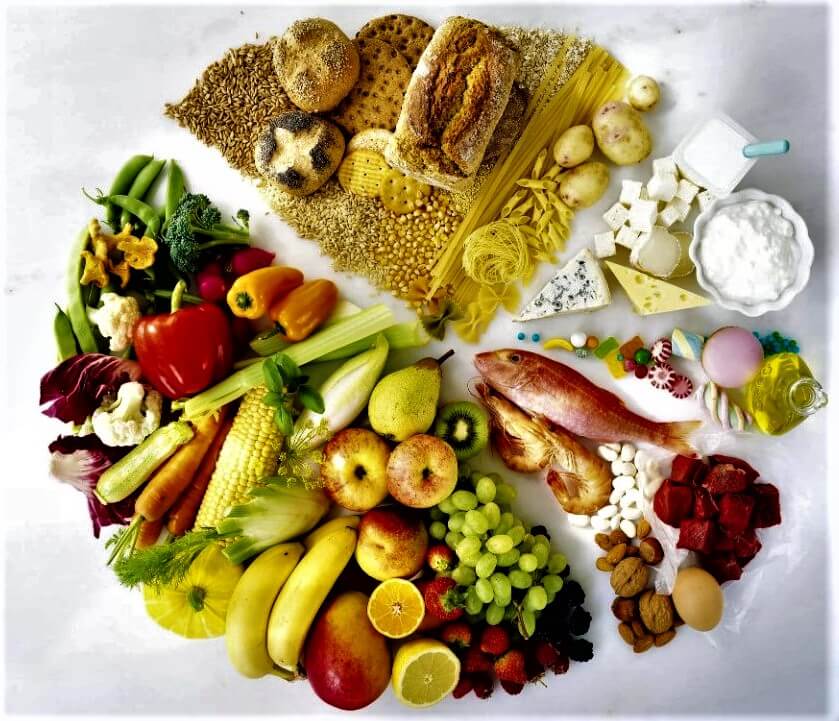To eat well without gaining weight, the trick is in the portions. And it is that many times we take care of what we put on the plate but neglect another important aspect: the quantity.
We all have more or less clear foods that we should choose so that our diet is healthy.
And yes, it seems that we are clear about what but sometimes we forget how much.
- FIRST CALCULATION: THE PYRAMID
- What do the new feeding guides say?
- WHAT TO EAT EVERY DAY?
- CEREALS AND DERIVATIVES: 70 GRAMS
- VEGETABLES AND VEGETABLES: BETWEEN 150 AND 200 GRAMS
- EGGS: 60 GRAMS (ONE MEDIUM)
- Does the egg raise or not raise cholesterol?
- 9 ways to cook legumes
- 8 seeds easy to use and that takes care of your health
FIRST CALCULATION: THE PYRAMID
We have a first reference in the so-called Nutritional Pyramid. Do you remember what it indicates? It graphically shows the rations and the frequency with which food should be taken from the different groups and includes practical tips:

- At the base, a healthy lifestyle:
- Perform one hour of exercise a day.
- Take care of emotions (mood influences when shopping, cooking and eating).
- Balance what is ingested and what is “burned”.
- Choose healthy culinary techniques.
- And drink enough (between 1.5 and 2 litres of water a day).
- First level: what should we eat daily
- It is separated into three floors. The first two should be in each main meal: cereals and starches; and vegetables, vegetables, fruits and olive oil.
IT MAY INTEREST YOUhttps://www.cnet.com/how-to/how-to-track-your-macros-guide/
What do the new feeding guides say?
The third includes foods whose nutrients we need daily but that we must alternate during the week: dairy, fish, white meat, legumes, nuts and eggs.
Second level:
food for occasional consumption
.This is divided into two floors: on one are red and processed meats (to be taken occasionally and in moderation).
.In the other, there are foods that should only be taken exceptionally: sugar, sweets, pastries and pastries, spreads and products rich in salts, such as aperitif and pre-cooked snacks.
WHAT TO EAT EVERY DAY?
But the pyramid is a general framework. Below we will explain in detail what the ideal portion of food weighs and how often you should take it.
Some should be included with every meal; others, once a day, but we all tell you the amount you need.
CEREALS AND DERIVATIVES: 70 GRAMS
Rice, wheat, oats, quinoa (and also starches like potatoes …) provide energy in the form of complex carbohydrates.
- How many servings. One at each meal, that is, 4 to 6 a day.
- Which size. In raw (rice, pasta …), a serving is 70 g, which would be the amount you can take with a closed fist. If you cook them without regret, the ideal would be the one that fits in a cupped hand. As for the potato, calculate 150-200 g (one large or two small).
IT MAY INTEREST YOUhttps://buzzrecipes.com/six-foods-that-give-you-serenity/
The guide to the 11 portions of cereal that you should include in your diet
And what about bread and breakfast cereals? A serving of bread weighs 50g (one bun, one hand-sized thin slice stretched out, or 2-3 slices of loaf bread). One of the flakes type cereals (it is important that they are without sugar), 30 g.
VEGETABLES AND VEGETABLES: BETWEEN 150 AND 200 GRAMS
Choose them in various colours to expand the range of substances they provide.
How many servings. Two daily at least and, if possible, fresh, seasonal and local. One of the two should be eaten raw (not all of them are possible).
- Which size. A serving is about 150-200 g, that is, a plate of mixed salad or one of the cooked vegetables. If you take them in puree or cream, the amount rises to 250 ml (one medium bowl).
- FRUITS: BETWEEN 150 AND 200 GRAMS
- Its sugar content is highly variable, but thanks to its richness in fibre, it is not harmful.
- How many servings. Three or more pieces (or servings) a day. It is better to take them whole than in juice since the latter loses the fibre.
- Which size. Between 150 and 200 g. For the small ones (strawberry, cherry, grape) the measure of a cup can be used. For the big ones (melon, pineapple, watermelon), two slices.
- FISH: 150 GRAMS
- Its nutrients include omega 3 fatty acids, more abundant in blue.
- How many servings. Between 3 and 4 servings a week combining white and blue.
- Which size. A 150 g fillet, or what is the same, a piece the size and thickness of the palm of the hand.
- WHITE MEAT: 125 GRAMS
- In lean cuts, it is advisable to remove the visible fat before cooking the food. In the case of birds, always discard the skin, since it is where the highest fat content is found.
- How many servings. Between 3 and 4 a week.
- Which size. A 125 g fillet, that is, the size of the palm of your hand or a quarter of chicken or rabbit.
IT MAY INTEREST YOUhttps://buzzrecipes.com/six-foods-that-give-you-serenity/
If you stop eating meat, will you be missing something?
White meats are rabbit and poultry such as chicken or turkey. But the lamb and the pig can also be it (it depends on the age of the animal, its diet and the cut).
For example, pork loin falls into the white meat group, as does lamb if it is young. Duck, goose or ostrich are considered red meat.
EGGS: 60 GRAMS (ONE MEDIUM)
Despite being a food rich in cholesterol, a review of 166 clinical studies has shown that taking one egg a day does not alter the lipid profile or increase cardiovascular risk.
- How many servings. Currently, it is considered adequate to take between 3 and 4 servings a week (which can be on consecutive days).
IT MAY INTEREST YOUhttps://www.healthline.com/nutrition/how-to-count-macros
Does the egg raise or not raise cholesterol?
- Which size. One medium (60 g) or two small ones.
- VEGETABLES: BETWEEN 60 AND 80 GRAMS
- It is advisable to cook them with simple techniques that improve their digestibility (try not to combine them with too many fatty foods) and that complete their nutritional value (for example, with cereals or nuts).
9 ways to cook legumes
- How many servings. Between 2 and 4 every week.
- Which size. 60-80 g raw, that is a closed fist. If they are cooked, the quantity is that of a normal plate or the one that fits inside the cupped hand if they are dry.
- DRIED FRUITS AND SEEDS: 25 GRAMS
- Scientific studies have shown that they play a protective role against cardiovascular diseases, especially if they are incorporated into a balanced diet as a substitute for foods rich in saturated fat. Its consumption is associated with a lower risk of diabetes and hypertension.
8 seeds easy to use and that takes care of your health
- How many servings. Between 3 and 7 a week, preferably raw or lightly toasted and without added sugar, salt and/or fat.
- Which size. One serving equals 25 g (a handful).
- MILK AND YOGHURT: BETWEEN 200 AND 250 GRAMS
- This group includes milk (semi-skimmed if calories are to be monitored), fermented kinds of milk (yoghurt, kefir) and cheeses.
- How many servings. Between two and three a day (for the entire group), depending on the age and characteristics of each person (most important during growth, pregnancy, menopause and from the age of 60).
- Which size. A serving of milk is equivalent to a glass of 200-250 ml. One of yoghurt, in two units (250 g in total).
- Cheese, a separate topic. If it is fresh, you can cut a piece of about 100 g. If you are going to take it grated, three-level tablespoons. And the adequate portion of the fattiest and rich in salt is between 40 g and 60 g: they should be taken in moderation (not every day)
what this video: How to calculate and track your macros

